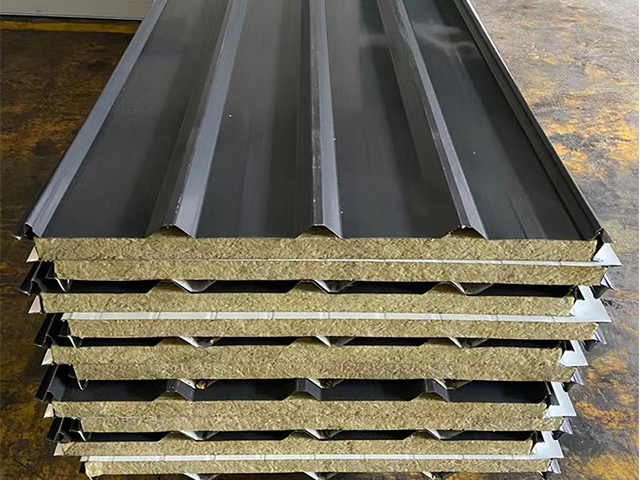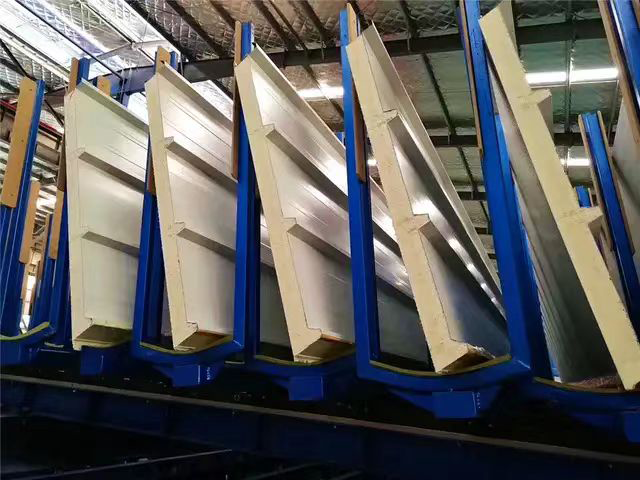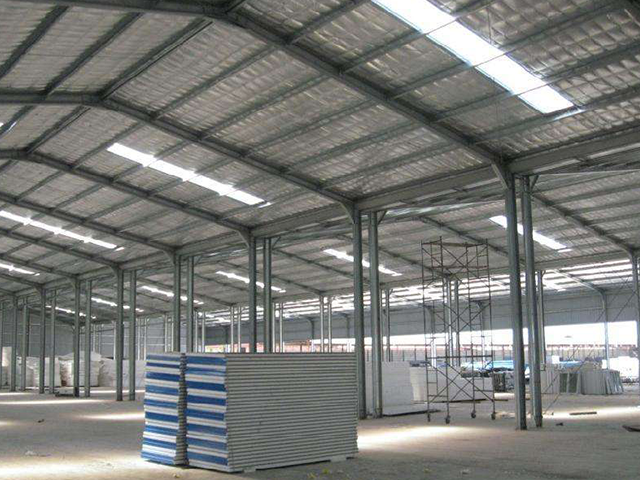Primary Steel Structure Designs for Construction Projects
Portal Frame Systems: Efficiency in Industrial Applications
Portal frames are characterized by their ease of construction and economy -- both of response and construction for their lack of out-of-plane bracing. They have a no-nonsense shape - a "hybrid" steel-and-concrete mix - to guarantee stability and minimal material usage. Moreover, another report shows that construction costs can be reduced by approximately 30% with portal frames compared to conventional construction technologies. This economy is particularly interesting for companies wishing to allocate their budgets more efficiently in construction.
Box Frame Configurations: Stability for High-Rise Buildings
[0005] Box frame arrangements are well known for their outstanding strong properties and are preferred for use in multi-story buildings where strength is essential. The frame types supple a uniform load distribution that can be of help to extend the service life and robustness of the skyscrapers. In high-rise, narrow urban settings the use of box frame systems has been found to reduce the construction time by decreasing the dependence upon scaffolding during the construction process. This level of efficiency positions these arrangements as an indispensable element in contemporary urban infrastructure construction.
Truss Systems: Versatility in Roof and Bridge Construction
Roofs and Bridges The most common applications for truss systems where the material’s strength can be utilized with high efficiency is in bridges and roofs where the weight must be distributed economically over long spans. These structures are applicable to any architectural styles and have the requisite strength to resist to severe weather conditions. Engineering studies have shown truss construction to be up to 30% lighter than traditional construction, reducing the amount of material used in construction and allowing more design flexibility. The versatility and economy of truss systems make them the preferred structural system of architects and builders who are looking for new and different ideas.
Prefabricated Steel Building Solutions
Benefits of Prefab House Kits for Rapid Construction
Prefab house kits present an easy solution to accelerate construction time while maintaining quality. By streamlining the construction process, all complete kit buildings allow for quick construction as all the components are included, thus shortening the erection time by up to 50% and saving you enormous amounts of money. Alongside their speed, prefab homes are also well-known for their energy efficiency, meaning that they help homeowners save on long-term utility costs. This energy efficiency results from the basic design of prefab buildings, with relatively little energy losses.
Customizable Metal Building Panels for Diverse Projects
Due to the design flexibility and functionality that custom metal building panels provide, they’re suitable for various building construction projects. Such panels can be tailored for.the various climates for weather-resistance and performance despite local conditions. With up to 40% of modern buildings using customized metal panels according to projected trends, the value of these materials to curb and wall design becomes more apparent. This versatility makes them ideal for use in commercial and residential applications, with which endless design attributes can be adopted.
Cost-Effective Steel Prefab House Options
Prefab steel homes are a much more budget-friendly option than traditional building, as the cost and low price point easily brings construction financing within reach. Market analyses reveal that choosing prefab steel results in.20-.30% overall price reductions due to material and labor savings. Additionally, steel buildings will save you money in the long run on maintenance costs that would otherwise add up if you were to choose wood over steel which becauseof its stability and sturdiness, often lasts longer. Good Price Because of the lower cost, steel prefab houses are more attractive for investors.
Material Selection in Steel Structure Buildings
Carbon Steel: Durability for Heavy-Duty Framing
Because of his strength and his shine, carbon steel is the reference material for heavy framing. Typically its minimum tensile strength is greater than 400 MPa to provide the tensile strength required for construction applications. Remarkably, carbon steel hulls are designed for a life in excess of 50 years with no significant life-time ageing. This is the longevity of it that provides for the perfect material for all those projects where you need for a strong framework We got you between strength and performance.
Rebar Steel: Reinforcing Concrete Composite Structures
Rebar steel has a crucial effect on the tensile strength and durability of concrete composite structures and reinforcing. Adding rebar to concrete adds 60 percent more strength and makes cracking less likely, providing protection from dangerous conditions and possible structural failure. Civil engineering professionals always recommend to use the high quality rebar in making safe as well as durable building to avoid the building collapse. This method of reinforcement is fundamental to long-term infrastructure construction, providing the concrete with the basic skeleton it needs to stand the test of time.
High-Strength Alloys for Lightweight Designs
The development of strong light materials, such as high-strength alloys, is of great interest for lightweight and strong designs, especially for applications in aerospace and automotive applications. Such materials also enable a substantial reduction of weight with excellent performance characteristics and safety values. STUDIES HAVE SHOWN THE USE OF HIGH STRENGTH ALLOYS CAN FURTHER AND UP TO 30 TO 40% PROJECT WEIGHT SAVING,-- RESULTING IN TRANSPORTATION AND FOUNDATION SAVINGS. This is why they are becoming high in demand for the construction industry of the high rising buildings, modern constructions that need effective utilization of the resources in ecofriendly manner.
Applications of Modern Steel Structures
Commercial Steel Buildings: Retail and Office Spaces
Most of today's metal retail and commercial buildings are highly customized in terms of design and functionality. Now that buildings are being designed with open floor plans, those structures are more energy efficient, allowing the owner more design flexibility and the option to configure their space to fit their own unique needs. This versatility contributes to the creation of an attractive look that has been demonstrated to draw more customers. Studies show that businesses located in steel structures experience 15-20% more foot traffic and that is primarily due to their aesthetic appeal and utility.
Industrial Steel Frameworks: Warehouses and Factories
Warehouse / Factory Support Industrial steel frames are ideal for support of warehouses and factory plants, there supporting these make warehouses and factory spaces much safer and higher storage capacity. These rugged constructions are built to handle industrial work with large, powerful machines helping you get the job done faster. Interestingly, figures show construction of Steel Building in industrial spaces increase workflow efficiency higher than 25%.
Residential Steel Prefab House Innovations
Steel prefab homes are a basic section that is produced in a factory to be shipped and assembled on-site. These homes are now being prefabricated and delivered at much faster rates given recent advances in technology, which by all means is a welcomed new reality for impatient homeowners. A lot of consumers are starting to love these steel built homes because of the sturdiness, environmental friendliness, and cost savings. It's a sign of the times - these days, it's more and more common to build green.
Sustainable Advances in Steel Construction
Recyclable Steel Components for Eco-Friendly Projects
Steel recycle components have an important role in environmentally responsible construction, reducing the amount of waste that ends up in the landfill. These products are a must-have in the arena of green projects, and more and more construction plans are incorporating a high percentage of recyclable materials, making them more sustainable. Besides the fact that they are recyclable, steel buildings are also designed to be extremely durable and will last for decades, reducing their environmental impact over time as well. The reusability and recyclability of steel further emphasizes its standing as a sustainable material option for contemporary construction projects.
Energy-Efficient Metal Building Panel Systems
Then, comes the era of energy-efficient metal building panel systems where energy consumption is being managed. Such systems are able to significantly cut down on heating and cooling costs for commercial or residential spaces with potential energy savigns being as high as 30%. According to energy auditors, adoption of these newer systems can raise a property's overall energy rating. This amounts to considerable long term savings and increased comfort and green value of steel structures.
Future Trends in Modular Steel Structure Design
The development of computeraided steel modular systems is a rapidly emerging field of research that seeks to truck steel modular concept, with the objective of both improving construction speed and adapting the design to different conditions. Fast forward just a few years and hi-tech solutions such as 3D printing and smart materials are on the verge of transforming the status quo in modular design, by making it easier and more personalised. This cutting edge construction is expected to represent around 15% of new projects in the industry by 2030, according to industry estimates. Given the increasing demand for rapid, efficient construction options, the future of construction is being set by modular steel prefab house innovations.






